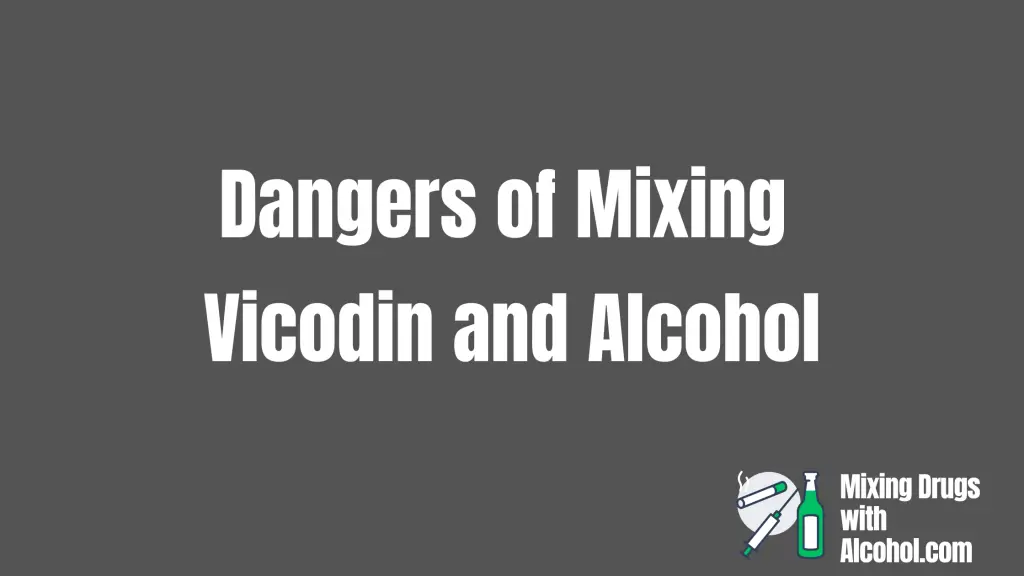Mixing Vicodin and alcohol can have severe health consequences, as both substances are central nervous system depressants that can cause exaggerated sedative effects and respiratory depression. Vicodin is an opioid painkiller used to treat moderate-to-severe pain, while alcohol can produce relaxation or euphoria when consumed in moderation.
However, combining even small amounts of these substances can be dangerous and increase the risk of overdose and life-threatening side effects such as slowed breathing and heart rate irregularities. This article explains why Vicodin should not be mixed with alcohol and what steps to take if someone is engaging in this risky behavior.
How Long After Taking Vicodin Can You Drink?
Mixing Vicodin and alcohol can be dangerous due to their similar sedative effects on the body. Taking both drugs together can intensify their effects and increase the risk of accidents, injuries, and even overdose. The combination can also lead to long-term liver damage due to the high toxicity levels of Vicodin when mixed with other medications. Therefore, it is not recommended to mix Vicodin and alcohol.
What Is Vicodin?
Vicodin is a prescription pain medication containing hydrocodone, an opioid derived from opium poppies that blocks pain signals while producing euphoria. It’s effective at treating acute or chronic pain, but can lead to abuse if not taken under medical supervision. Hydrocodone mimics endorphins by attaching to mu-opioid receptors, while acetaminophen helps reduce fever and relieve aches and pains.
Proper use under medical guidance can provide relief, but misuse can cause dangerous side effects and long-term dependence. Speak with your doctor before taking opioids like Vicodin.
Is It Safe To Take Vicodin With Alcohol?
Combining Vicodin and alcohol is dangerous, as they can enhance each other’s side effects and increase the risk of overdose and other adverse health consequences. Alcohol enhances the pain-relieving and sedative effects of Vicodin, leading to excessive drowsiness, confusion, impaired judgement, and risky behavior.
The combination can also cause slowed breathing rates, oxygen deprivation, and death. It is essential for anyone taking Vicodin to avoid alcohol until cleared by a physician. Patients who drink alcohol regularly should inform their doctor to receive proper dosage instructions.
Side-Effects Of Taking Vicodin And Alcohol
Mixing Vicodin (hydrocodone and acetaminophen) and alcohol can have serious short and long-term side effects on a person’s health. Here are some common short and long-term side effects of taking Vicodin and alcohol together:
Short-term side effects:
-
- Increased drowsiness and sedation
- Impaired coordination and balance
- Difficulty concentrating and thinking clearly
- Nausea and vomiting
- Slowed or shallow breathing
- Increased risk of accidents and injuries
- Increased risk of overdose and death
Long-term side effects:
-
- Chronic liver damage and failure
- Increased risk of gastrointestinal bleeding and ulcers
- Kidney damage and failure
- Increased risk of cardiovascular disease and stroke
- Chronic pain and addiction to opioids
- Alcohol use disorder and addiction
Additionally, combining Vicodin and alcohol can increase the likelihood of developing serious health problems, such as respiratory depression, coma, and death. It is crucial to follow the prescribed dosage of Vicodin and avoid consuming alcohol while taking this medication. It is also recommended to consult a healthcare provider before consuming any alcohol or combining it with other medications.
How To Take Medication Safely
When taking any medication, including Vicodin, it’s essential to follow the dosage and timing instructions provided by your doctor or pharmacist. It’s best to consult a medical professional if you have any questions about how to take the medication safely.
To avoid overdosing, patients taking opioids like Vicodin should know their alcohol tolerance levels. Taking Vicodin with food may help reduce gastrointestinal symptoms. Drinking alcohol while on Vicodin is not recommended due to potential risks, but if you choose to, start slowly and stay within your limits, never exceeding your physician’s prescription.
Taking Vicodin And Other Drugs
Mixing Vicodin with alcohol or other drugs is strongly discouraged due to the unpredictable and potentially dangerous effects it can have. Both substances are depressants that can cause slowed breathing, confusion, impaired judgment, and even coma or death.
Combining Vicodin with alcohol, in particular, can lead to significant drops in blood pressure, liver failure, or heart attack. Patients should avoid mixing different drugs unless necessary and consult their doctor or pharmacist for possible interactions. It’s crucial to take medications exactly as directed by healthcare providers and track usage to ensure safe use.
Vicodin And Caffeine Interaction
Caffeine can speed up the absorption of Vicodin into the bloodstream, potentially leading to overdose or serious side-effects. Additionally, caffeine can increase alertness, which can be detrimental when taking Vicodin since its sedative effects might be too strong.
It is best to avoid consuming caffeinated beverages while taking Vicodin as this could cause dangerous fluctuations in blood pressure and heart rate. Speak with your doctor about what dose would be appropriate for your individual needs if you must consume both substances at once to safely take them together without putting yourself at risk.
Frequently Asked Questions About Dangers of Mixing Vicodin And Alcohol
What happens if you take a painkiller with alcohol?
Mixing painkillers with alcohol can increase the risk of serious side effects, such as respiratory depression, overdose, and death. Alcohol can also interfere with the metabolism of painkillers, leading to increased drug concentrations in the blood and potentially toxic effects.
What painkillers Cannot mix with alcohol?
Painkillers that should not be mixed with alcohol include opioid pain relievers such as oxycodone, hydrocodone, and codeine, as well as non-opioid painkillers such as acetaminophen and nonsteroidal anti-inflammatory drugs (NSAIDs) like aspirin, ibuprofen, and naproxen.
How long after painkiller Can I drink alcohol?
It is recommended to wait at least 24 hours after taking a painkiller before consuming alcohol. However, it is best to consult a healthcare provider before consuming any alcohol or combining it with medications, as the timing may vary depending on the type of painkiller and individual factors.
Can you drink alcohol while taking hydrocodone Homatropine?
No, drinking alcohol while taking hydrocodone Homatropine can increase the risk of serious side effects, including respiratory depression, overdose, and death. It is crucial to follow the prescribed dosage of hydrocodone Homatropine and avoid consuming alcohol while taking this medication.
Can I drink alcohol after taking Tylenol?
It is recommended to wait at least 2-3 hours after taking Tylenol (acetaminophen) before consuming alcohol. However, it is important to note that excessive alcohol consumption can damage the liver, and taking Tylenol and alcohol together can increase the risk of liver damage. Therefore, it is best to consult a healthcare provider before consuming any alcohol or combining it with medications.
1.Substance Abuse and Mental Health Services Administration (SAMHSA). (2018). Key substance use and mental health indicators in the United States: Results from the 2018 National Survey on Drug Use and Health (HHS Publication No. PEP19-5068, NSDUH Series H-54). Rockville, MD: Center for Behavioral Health Statistics and Quality, Substance Abuse and Mental Health Services Administration. Retrieved from https://www.samhsa.gov/data/report/2018-nsduh-annual-national-report
2.National Institute on Drug Abuse (NIDA). (2018). Overdose death rates. Retrieved from https://www.drugabuse.gov/related-topics/trends-statistics/overdose-death-rates
3.National Institute on Alcohol Abuse and Alcoholism (NIAAA). (2020). Alcohol facts and statistics. Retrieved from https://www.niaaa.nih.gov/publications/brochures-and-fact-sheets/alcohol-facts-and-statistics
4.Hinkin, C. H., Castellon, S. A., Durvasula, R. S., Hardy, D. J., Lam, M. N., Mason, K. I.,… Stefaniak, M. (2001). Medication adherence among HIV+ adults: Effects of cognitive dysfunction and regimen complexity. Neurology, 57(4), 748-754. doi: 10.1212/WNL.57.4.748
5.O’Brien, C. P. (2006). Benzodiazepine use, abuse, and dependence. Journal of Clinical Psychiatry, 67(Suppl. 5), 28-33. doi: 10.4088/JCP.1006e09
6.Wong, A., Benedict, N. J., Armahizer, M. J., Kane-Gill, S. L. (2014). Evaluation of opioid and benzodiazepine co-prescribing in a tertiary care intensive care unit. Journal of Pharmacy Practice, 27(2), 114-119. doi: 10.1177/0897190013503558
7.Centers for Disease Control and Prevention (CDC). (2021). Prescription opioid overdose data. Retrieved from https://www.cdc.gov/drugoverdose/data/prescribing/overdose-death-maps.html
8.World Health Organization (WHO). (2010). Guidelines for the psychosocially assisted pharmacological treatment of opioid dependence. Geneva: World Health Organization. Retrieved from https://www.who.int/publications/i/item/9789241547543
9.American Society of Addiction Medicine (ASAM). (2015). The ASAM National Practice Guideline for the Use of Medications in the Treatment of Addiction Involving Opioid Use. Retrieved from https://www.asam.org/docs/default-source/practice-support/guidelines-and-consensus-docs/asam-national-practice-guideline-supplement.pdf
10.U.S. Food and Drug Administration (FDA). (2022). Vicodin (hydrocodone bitartrate and acetaminophen) tablets. Retrieved from https://www.accessdata.fda.gov/drugsatfda_docs/label/2022/007015s081lbl.pdf
Similar Articles
Prednisone And Alcohol
Amoxicillin and Alcohol
Lexapro and Alcohol
Doxycycline Hyclate and Alcohol
Antidepressants and Alcohol
Muscle Relaxers and Alcohol
Nitrofurantoin and Alcohol
Blood Thinners and Alcohol
Pfizer vaccine and Alcohol
Valacyclovir and Alcohol
Indomethacin and Alcohol
Ashwagandha and Alcohol
Mirtazapine and Alcohol
Wellbutrin and Alcohol
Sertraline and Alcohol
Amlodipine and Alcohol
lisinopril and Alcohol
Duloxetine and Alcohol
Lorazepam and Alcohol
Oxycodone and Alcohol
Baclofen and Alcohol
Suboxone and Alcohol
Losartan and Alcohol
Metformin and Alcohol
Cefdinir and Alcohol
Nyquil and Alcohol
Meloxicam and Alcohol
Prozac and Alcohol

